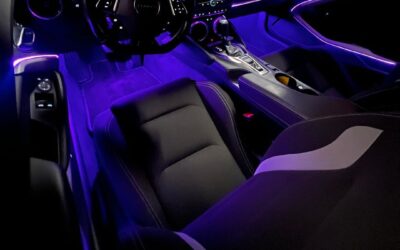How Automotive LED Lighting Enhances Safety During Nighttime Driving

Introduction to Automotive LED Lighting
Automotive LED lighting has transformed the way vehicles illuminate roads, offering brighter, more energy-efficient alternatives to traditional halogen and incandescent lights. The adoption of LED technology in vehicles has grown rapidly over the past decade, driven by advancements from leading automotive led lighting manufacturers. These lights not only enhance the aesthetic appeal of vehicles but also play a significant role in improving nighttime driving safety. Understanding their impact is crucial for both drivers and the automotive industry as a whole.
Enhanced Visibility and Road Illumination
One of the primary benefits of automotive LED lighting is its ability to significantly improve visibility during nighttime driving. LEDs provide a more focused and intense beam of light, which allows drivers to see obstacles, road signs, and pedestrians more clearly. Unlike traditional halogen lights that can scatter light and create glare, LED lights maintain consistent brightness, reducing eye strain and improving reaction times. Automotive led lighting manufacturers have optimized these systems to offer a wider color temperature range, closely mimicking natural daylight, which is easier for the human eye to process in low-light conditions. This enhanced illumination can reduce the likelihood of accidents caused by poor visibility.
Faster Response Times and Safety
LED lights are known for their almost instantaneous response times compared to conventional bulbs. When drivers use brake lights or turn signals, LED technology ensures that other motorists receive visual cues immediately. This rapid response can be critical in preventing collisions, especially in high-traffic areas or during sudden stops. Automotive led lighting manufacturers design these systems to meet stringent safety standards, ensuring that the lights activate reliably under all conditions. Faster signaling reduces the reaction time required by other drivers, contributing to a safer driving environment at night.
Longevity and Reliability
Another factor contributing to nighttime driving safety is the durability of LED lighting systems. LEDs have a much longer lifespan compared to halogen or incandescent bulbs, meaning they are less likely to fail unexpectedly. Reduced failure rates decrease the chances of driving with compromised lighting, which is particularly dangerous at night. Automotive led lighting manufacturers focus on producing lights that can withstand extreme temperatures, vibrations, and moisture, ensuring that drivers can rely on consistent performance throughout the life of the vehicle. This reliability is essential for maintaining safe driving conditions and avoiding nighttime accidents caused by faulty lights.
Adaptive Lighting Systems
Modern vehicles increasingly feature adaptive LED lighting systems designed to optimize illumination based on driving conditions. These systems automatically adjust the intensity and direction of light in response to factors such as speed, weather, and the curvature of the road. By providing targeted illumination where it is most needed, adaptive LED lights reduce the risk of accidents on winding roads or during adverse weather conditions. Automotive led lighting manufacturers have invested in sensor-driven technologies that allow these adaptive systems to respond dynamically, offering drivers better visibility and safer nighttime experiences.
Reduced Glare and Improved Comfort
Glare from oncoming vehicles is a common hazard during nighttime driving, often leading to temporary blindness and increasing the risk of accidents. Automotive LED lighting helps mitigate this problem by producing more controlled beams of light. Advanced LED designs allow for precise cut-offs, ensuring that light is directed toward the road without blinding other drivers. By reducing glare, LED lighting not only protects the driver but also enhances overall road safety for everyone. Automotive led lighting manufacturers continue to innovate in this area, creating lighting solutions that prioritize both visibility and comfort.
Energy Efficiency and Environmental Benefits
While the safety advantages of automotive LED lighting are paramount, the energy efficiency of these systems also indirectly contributes to safer nighttime driving. LEDs consume less power than traditional lighting solutions, reducing the load on the vehicle’s electrical system. This efficiency ensures that all lighting components operate at optimal levels, including headlights, brake lights, and interior illumination, without compromising performance. By decreasing energy consumption, automotive led lighting manufacturers support the development of sustainable vehicles that maintain safety without unnecessary energy waste.
Impact on Driver Fatigue
Nighttime driving can be physically and mentally exhausting due to reduced visibility and the strain placed on the eyes. Automotive LED lighting mitigates this issue by providing brighter, more evenly distributed illumination that closely resembles natural daylight. This reduces the effort required for drivers to detect hazards and read road signs, lowering fatigue levels. Automotive led lighting manufacturers incorporate technologies such as adaptive high beams and anti-glare designs to maintain consistent lighting quality, helping drivers stay alert and focused on the road. Reduced fatigue directly correlates with improved reaction times and safer driving behavior.
Influence on Accident Rates
Research has shown that vehicles equipped with LED lighting systems tend to have lower nighttime accident rates. Enhanced visibility, faster signaling, adaptive lighting, and reduced glare all contribute to safer driving conditions. By implementing cutting-edge designs, automotive led lighting manufacturers play a critical role in lowering the risk of collisions and improving overall traffic safety. The widespread adoption of LED lighting in modern vehicles continues to shape safer driving practices, particularly in regions where nighttime driving is frequent or where road infrastructure may be poorly lit.
Future Developments in Automotive LED Lighting
The evolution of automotive LED lighting is far from complete. Future innovations from automotive led lighting manufacturers are likely to include even more advanced adaptive systems, intelligent matrix lighting, and integration with autonomous vehicle technologies. These advancements aim to further enhance nighttime driving safety by providing predictive illumination, better hazard detection, and smarter interactions with surrounding traffic. As research and development continue, LED lighting systems are expected to play an increasingly vital role in reducing accidents and improving road safety globally.
Conclusion
Automotive LED lighting has profoundly impacted nighttime driving safety by offering superior visibility, faster response times, and reliable performance. With contributions from automotive led lighting manufacturers, these systems have evolved to include adaptive technologies, glare reduction, and energy-efficient designs, all of which directly enhance driver safety. By reducing fatigue, improving hazard detection, and lowering accident rates, LED lighting represents a significant advancement over traditional vehicle lighting solutions. As the technology continues to advance, drivers can expect even safer nighttime driving experiences, making LED lighting an indispensable component of modern automotive safety.











